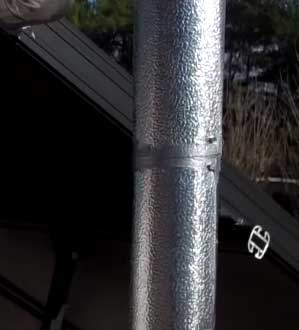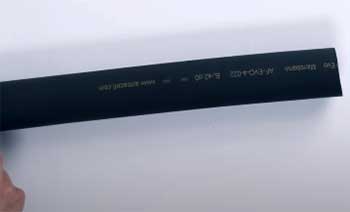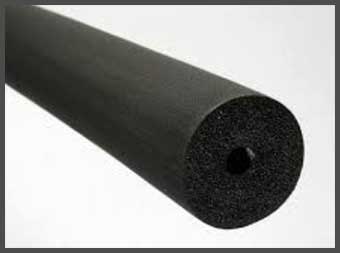When it comes to insulating pipes, ductwork, and other applications, Rubatex and Armaflex are two of the most popular options on the market. But what exactly are these insulations, and how do they compare in terms of performance, cost, and ease of installation?
This comprehensive guide examines the key differences between Rubatex and Armaflex to help you determine which insulation is the right choice for your specific needs.
A Brief Comparison Table
| Feature | Rubatex | Armaflex |
| Material | Nitrile butadiene rubber | Polyethylene foam rubber |
| Thermal Conductivity | 0.25 BTU-in/hr-ft2-°F | 0.25-0.29 BTU-in/hr-ft2-°F |
| R-Value per Inch | ~4.0 | 4.2-4.3 |
| Temperature Range | -297°F to 300°F | -297°F to 220°F |
| Flexibility | Good | Excellent |
| Chemical Resistance | Excellent | Good |
| Mold/Mildew Resistance | Excellent | Very Good |
| Installation | Self-adhesive or contact adhesive | Self-adhesive strips or contact adhesive |
What Is Rubatex Insulation?
Rubatex is a closed-cell, elastomeric foam insulation made from a nitrile butadiene rubber. It is designed to insulate pipes, tanks, ductwork, and equipment operating between -297°F and 300°F.
Some of the key features and benefits of Rubatex insulation include:

- Closed-cell structure – The closed-cell structure contains millions of tiny nitrogen-filled cells per cubic inch, giving Rubatex exceptional thermal performance and low moisture permeability.
- Flexibility – Rubatex has good flexibility and conformity, making it easier to install on pipes with elbows and fittings. The insulation is able to stretch up to 200% of its normal shape.
- Mold, mildew, and UV resistance – With its closed-cell structure, Rubatex resists mold, mildew, and UV damage. It can be installed outdoors without additional protection.
- High R-value – Rubatex provides an R-value of around 4.0 per inch of thickness. This high insulating value helps minimize heat gain/loss.
- Vibration damping – The elasticity of the nitrile rubber absorbs vibrations and reduces noise from pipes and equipment.
- Oil and chemical resistance – Rubatex is resistant to many oils, solvents, and chemicals, making it suitable for insulating pipes in industrial plants.
Some popular applications for Rubatex include insulating chilled water and refrigeration pipes, HVAC ducts, tanks, and outdoor piping systems. It’s available in tube, sheet, and roll formats.
What Is Armaflex Insulation?
Armaflex is a flexible, elastomeric thermal insulation made from closed-cell, foam rubber materials. It was originally developed in the 1960s and is today manufactured by Armacell.
Key features and benefits of Armaflex include:
- Flexible, elastomeric foam – Made from a flexible nitrile rubber, Armaflex can stretch up to twice its normal size to fit tightly over pipes and odd shapes.
- Closed-cell structure – The closed cells contain pockets of air that act as effective thermal insulators while resisting moisture.
- Self-sealing – Armaflex has a smooth exterior that is self-sealing when compressed or punctured, helping it maintain insulation value.
- Easy installation – Armaflex can be slipped over pipes or wrapped around ducts, vessels, and fittings without adhesives or heat. Minimal tools are required.
- Long service life – Properly installed Armaflex can have a service life of over 25 years. It is also UV and weather resistant for outdoor use.
- Wide temperature range – Can insulate in temperatures from -297°F up to +220°F. Effective across a broad range of services.
- Noise reduction – Helps absorb noise from vibrating pipes and HVAC systems.
Armaflex insulation comes in tubes, sheets, rolls, and fittings. It’s designed for thermal and acoustic insulation in HVAC, refrigeration, mechanical systems, and more.
Rubatex And Armaflex: Key Differences
Now that we’ve covered the basics of Rubatex and Armaflex insulation, let’s examine how they differ in several key categories:
- Performance and R-Value
Both Rubatex and Armaflex offer good thermal performance, but Rubatex generally has a higher R-value (insulating value) per inch of thickness:
- Rubatex R-value: ~4.0 per inch
- Armaflex R-value: ~4.2 to 4.3 per 0.5 inch
This means Rubatex provides slightly better insulation, though both insulations are effective at reducing heat transfer. Rubatex also has lower thermal conductivity than Armaflex.
- Temperature Range

The maximum service temperature for Rubatex is 300°F, while Armaflex can withstand continuous exposure up to 220°F.
At lower temperatures, Rubatex is rated down to -297°F compared to -297°F for Armaflex.
So Armaflex has a slightly wider overall service temperature range, though both insulations can handle a broad span of temperatures.
- Chemical Resistance
Rubatex offers better resistance to oils, solvents, greases and other chemicals. Its nitrile rubber formula provides protection across a wide array of corrosive industrial fluids and vapors.
Armaflex has relatively good chemical resistance, but Rubatex is more impervious overall. Armaflex may allow some absorption or penetration when exposed to harsh chemicals long-term.
- Mold and Mildew Resistance
The closed-cell structures of both insulations resist mold and mildew. However, Rubatex may have a slight edge here as its cells contain nitrogen compared to the air pockets in Armaflex.
- Fire Performance
Rubatex and Armaflex have similar fire performance with a UL 94 flame class rating of HF-1. Both insulations are self-extinguishing and do not promote flame spread.
- Cost and Value
Rubatex is generally more expensive than Armaflex insulation. But when you factor in its higher R-value and broader chemical resistance, Rubatex offers good value for the cost. It also carries long warranties when properly installed.
Armaflex is a slightly more economical option per square foot. It provides very effective insulation at a moderate price point.
Key Differences Summary
To recap the key differences:
- Thermal performance – Rubatex has a higher R-value per inch compared to Armaflex.
- Temperature range – Armaflex is rated for slightly higher maximum temperatures.
- Chemical resistance – Rubatex provides better resistance to oils and chemicals.
- Mold/mildew resistance – Slight edge to Rubatex.
- Fire ratings – Similar between both insulations.
- Cost – Rubatex is generally more expensive than Armaflex.
Rubatex And Armaflex: Which Is Best For Your Application?
So when choosing between Rubatex and Armaflex insulation, which is the better option?
Here are a few key factors to keep in mind:
- If chemical or oil resistance is critical, Rubatex is likely the better choice given its nitrile rubber construction.
- For hot service temperatures exceeding 220°F, Armaflex may be better equipped to handle the higher heat.
- For economic insulation of chillers, ducts, and commercial HVAC, Armaflex is hard to beat on price.
- For extreme low temp services below -297°F, both insulations are suitable options.
- For ease of installation, Armaflex’s high flexibility makes wrapping pipes simpler. But Rubatex also has good conformity.
- If noise reduction is important, Rubatex provides excellent vibration damping properties.
- For exposed outdoor applications, either insulation will work, but Rubatex may have a slight advantage in outdoor durability.
Analyze your specific temperature requirements, chemical exposure risks, noise control needs, and budget to decide if Rubatex or Armaflex is the right insulation for the job. Both offer excellent performance when installed properly.
Installing Rubatex and Armaflex Insulation
Proper installation is critical to get the advertised performance from these insulations. Here are some best practices to follow:

- Surface Prep – Clean all surfaces of dirt, oil, moisture and rust. Fill dents and smooth welds for a flush surface.
- Sizing – Size the insulation with around 10-20% compression so it fits tightly to pipes and equipment.
- Cutting – Use sharp knives or fine-tooth saws, replacing blades frequently for smooth cuts.
- Seams – Butt seam all insulation joints tightly. Seal with recommended adhesive.
- Elbows – Make miter or bell joint cuts to fit tightly around elbows. Stagger seams.
- Hangers – Use high-compressive strength inserts at support points to prevent insulation from sagging.
- Outdoors – Seal outdoor insulation joints with weather-resistant flashing tape. Provide shielding from direct sun exposure.
- Final Check – Inspect insulation for gaps, tears, loose joints and proper compression. Repair any issues.
Following manufacturer specifications for storage, prep, installation methods, adhesives, and weatherproofing is highly recommended. Taking the time to properly install insulation ensures you will get the rated R-value and performance.
Frequently Asked Questions (FAQ)
Rubatex is a closed-cell, flexible elastomeric insulation made from nitrile butadiene rubber. It provides thermal and acoustical insulation for pipes, tanks, ducts and equipment. Key benefits include high R-value, vibration damping, and chemical resistance.
Armaflex is also a flexible, closed-cell elastomeric insulation, but it is made from a foam rubber material. It has good conformity for wrapping pipes and ductwork. It is easy to install without adhesives.
Yes, Armacell manufactures and markets Armaflex brand insulation products. Armaflex is the trade name for their line of flexible foam rubber insulations.
The thermal conductivity of Armaflex insulation ranges from 0.25 to 0.29 BTU-in/hr-ft2-°F. The R-value is 4.2 to 4.3 per 1/2 inch thickness. It has a UL 94 HF-1 flammability rating and is self-extinguishing.
Closing Remarks
In summary, both Rubatex and Armaflex offer excellent insulating performance across a wide temperature range. Armaflex is easier to install, more economically priced, and available in more configurations.
But Rubatex provides superior resistance to chemicals/oils along with higher R-value per inch.
Carefully evaluate your application conditions and requirements to decide if Rubatex or Armaflex is the right solution for your project. Proper installation is key to achieving the rated performance.
With its strong track record and warranty, you can be confident choosing either insulation. Just be sure to select the product that best fits your specific needs.

My dad started with Rubatex back in the 40’s and I ran the Rubatex sales in NY form 1970 through 1995. I have contacts with many past customers…. Please let me know if you need any information… and I will check my past responses with our old customers on the East Coast and Cananda
Hi Ralph
We have an enquiry for ArmaFlex/Armacil, we are looking to offer an alternative which match the specification, also fire approvals in compliance with IMO FTP Code (MED) Fire certification.
Kindly advise if Rubatex meets the requirements, if so, can you send us an offer
Regards
Jamal